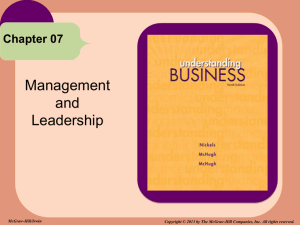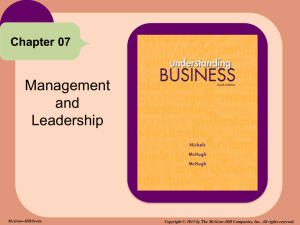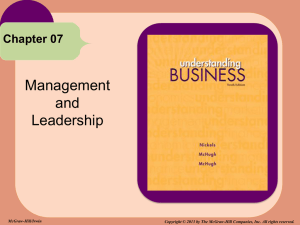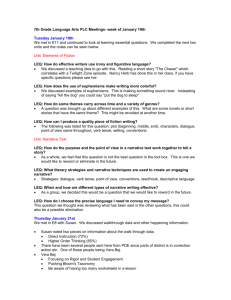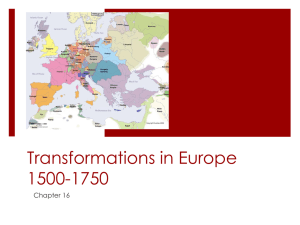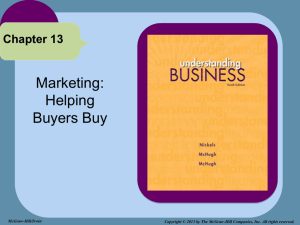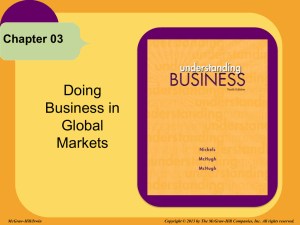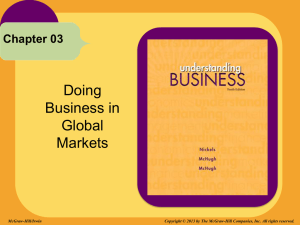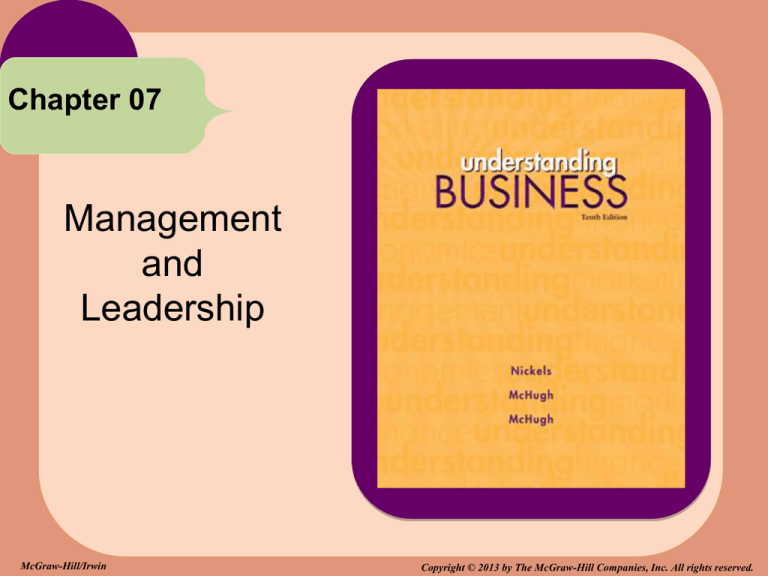
Chapter 07
Management
and
Leadership
McGraw-Hill/Irwin
Copyright © 2013 by The McGraw-Hill Companies, Inc. All rights reserved.
Chapter Seven
LEARNING GOALS
1.
Describe the changes occurring today in the management
function.
2.
Describe the four functions of management.
3.
Relate the planning process and decision making to the
accomplishment of company goals.
4.
Explain the differences between leaders and managers, and
describe the various leadership styles.
5.
Summarize the five steps of the control function of management.
7-2
Four Functions
of Management
WHAT IS MANAGEMENT?
LG1
• Management -- The process used to accomplish
organizational goals through planning, organizing,
leading and controlling people and other
organizational resources.
7-3
Managers’ Roles
Are Evolving
TODAY’S MANAGERS
LG1
• Younger and more
progressive.
- Growing numbers of women.
- Fewer from elite universities.
• Emphasis is on teams and
team building.
• Managers need to be skilled
communicators and team
players.
7-4
Four Functions
of Management
LG2
FOUR FUNCTIONS of
MANAGEMENT
1. Planning
2. Organizing
3. Leading
4. Controlling
7-5
Planning &
Decision Making
LG3
SHARING the VISION…and MISSION
• Vision -- More than a
goal, it’s a broad
explanation of why the
organization exists and
where it’s trying to go.
• Mission Statement -Outlines the
organization’s
fundamental purposes.
It includes: philosophy,
self-concept; social
responsibility;
products/services
7-6
Planning &
Decision Making
LG3
SETTING
GOALS and OBJECTIVES
• Goals -- The broad, long-term
accomplishments an
organization wishes to attain.
• Objectives -- Specific, shortterm statements detailing how
to achieve the organization’s
goals.
7-7
Planning &
Decision Making
LG3
PLANNING ANSWERS
FUNDAMENTAL QUESTIONS
• What is the situation now?
SWOT Analysis -- Analyzes the organization’s
Strengths, Weaknesses, Opportunities and Threats.
• How can we get to our goal from here?
-
Strategic planning
Tactical planning
Operational planning
Contingency planning
7-8
Planning &
Decision Making
LG3
STRATEGIC and TACTICAL
PLANNING
• Strategic Planning -- Done by top management
and determines the major goals of the organization
and the policies, procedures, strategies and
resources it will need to achieve them.
• Tactical Planning -- The process of developing
detailed, short-term statements about what is to be
done, who is to do it and how.
7-9
Planning &
Decision Making
LG3
OPERATIONAL and CONTINGENCY
PLANNING
• Operational Planning -- The process of setting
work standards and schedules necessary to
implement the company’s tactical objectives.
• Contingency Planning -The process of preparing
alternative courses of action
the firm can use if its primary
plans don’t work out.
7-10
Decision Making:
Finding the Best
Alternative
DECISION MAKING
LG3
• Decision Making -- Choosing among two or more
alternatives.
7-11
Decision Making:
Finding the Best
Alternative
LG3
RATIONAL DECISION-MAKING
MODEL
1. Define the situation.
2. Describe and collect needed information.
3. Develop alternatives.
4. Develop agreement among those involved.
5. Decide which alternative is best.
6. Do what is indicated.
7. Determine whether the decision was a good one
and follow up.
7-12
Decision Making:
Finding the Best
Alternative
PROBLEM SOLVING
LG3
• Problem Solving -- The process of solving the
everyday problems that occur; less formal than
decision making and needs quicker action.
• Problem-solving techniques include
brainstorming and PMI -- Listing all the pluses for a
solution in one column, all the minuses in another
and the implications in a third.
7-13
Organizing:
Creating a
Unified System
ORGANIZATIONAL CHARTS
LG4
• Organization Chart -A visual device that
shows relationships
among people and
divides the
organization’s work; it
shows who reports to
whom.
7-14
Organizing:
Creating a
Unified System
MANAGEMENT LEVELS
LG4
• Top Management -- The highest level, consists
of the president and other key company executives
who develop strategic plans.
• Middle Management -- Includes general
managers, division managers, and branch and
plant managers who are responsible for tactical
planning and controlling.
• Supervisory Management -- Those directly
responsible for supervising workers and evaluating
daily performance.
7-15
Organizing:
Creating a
Unified System
LG4
AMERICA’S MOST POWERFUL
FEMALE MANAGERS
Rank
Name
Organization
1
Indra Nooyi
PepsiCo
2
Irene Rosenfeld
Kraft Foods
3
Patricia Woertz
Archer Daniel Midland
(ADM)
4
Angela Braly
WellPoint
5
Andrea Jung
Avon Products
6
Oprah Winfrey
Harpo and OWN
7
Ellen Kullman
DuPont
8
Ginni Rommetty
IBM
9
Ursula Burns
Xerox
10
Carol Bartz
Yahoo!
Source: Fortune Magazine, www.fortune.com, accessed June 2011.
7-16
Tasks and Skills
at Different Levels
of Management
MANAGERIAL SKILLS
LG4
• Technical Skills -- The ability to perform tasks in a
specific discipline or department.
• Human Relations Skills -- Skills that involve
communication and motivation; they enable
managers to work through and with people.
• Conceptual Skills -- Skills that involve the ability to
picture the organization as a whole and the
relationship among its various parts.
7-17
Staffing: Getting
and Keeping the
Right People
STAFFING
LG4
• Staffing -- Recruiting, hiring, motivating and
retaining the best people available to accomplish the
company’s objectives.
• Recruiting good
employees is critical.
• Many people are not
willing to work at
companies unless they
are treated well with
fair pay.
7-18
Leading: Providing
Continuous Vision
and Values.
LEADERSHIP
LG5
• Leaders must:
- Communicate a vision
and rally others around
that vision.
- Establish corporate
values.
- Promote corporate
ethics.
- Embrace change.
- Stress accountability and
responsibility.
7-19
Leading: Providing
Continuous Vision
and Values.
LG5
ACCOUNTABILITY through
TRANSPARENCY
• Transparency -The presentation of
the company’s facts
and figures in a way
that is clear and
apparent to all
stakeholders.
7-20
Leadership
Styles
LEADERSHIP STYLES
LG5
• Autocratic Leadership -Making managerial decisions
without consulting others.
• Participative or Democratic
Leadership -- Managers and
employees work together to
make decisions.
• Free-Rein Leadership -Managers set objectives and
employees are free to do
whatever is appropriate to
accomplish those objectives.
7-21
Leadership
Styles
NATURAL BORN LEADERS?
Four Types of Executives
LG5
Rationalists
Humanists
Politicists
Culturists
Source: CIO Magazine, www.cio.com.
7-22
Empowering
Workers
EMPOWERMENT
LG5
• Progressive leaders give employees the
authority to make decisions on their own without
consulting a manager.
• Customer needs are handled quickly.
• Manager’s role becomes less of a boss and
more of a coach.
• Enabling -- Giving workers the education and tools
they need to make decisions.
7-23
Empowering
Workers
LG5
WORK SMARTER
How to Ease Pressure on Workers
• Manage output instead of hours.
• Train workers to be ready for a more complex
corporate structure.
• Allow lower-level managers to make decisions.
• Use new technology to foster teamwork.
• Shift hiring emphasis to collaboration.
Source: Bloomberg BusinessWeek, www.businessweek.com.
7-24
Managing
Knowledge
MANAGING KNOWLEDGE
LG5
• Knowledge Management -Finding the right information,
keeping the information in a
readily accessible place and
making the information known
to everyone in the firm.
• Tries to keep people from
reinventing the wheel.
7-25
Controlling:
Making Sure it
Works
FIVE STEPS of CONTROLLING
LG6
7-26
A Key Criterion
for Measurement:
Customer
Satisfaction
MEASURING SUCCESS
LG6
• Traditional forms of measuring success are
financial.
• Pleasing employees, stakeholders and customers
is important.
• External Customers -- Dealers, who buy products
to sell to others, and ultimate customers (or end
users), who buy products for their own use.
• Internal Customers -- Individuals and units within
the firm that receive services from other individuals or
units.
7-27

